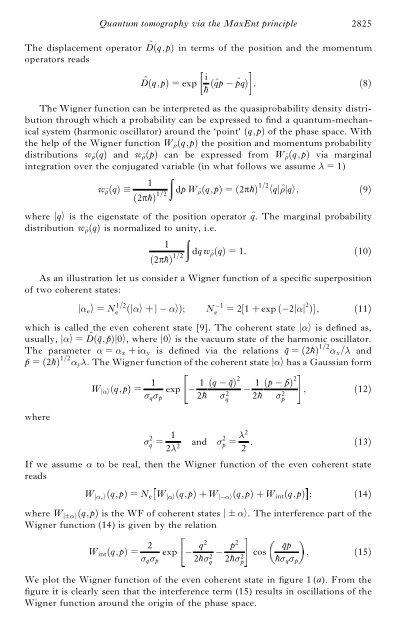Quantum tomography via the MaxEnt principle
Quantum tomography via the MaxEnt principle
Quantum tomography via the MaxEnt principle
Create successful ePaper yourself
Turn your PDF publications into a flip-book with our unique Google optimized e-Paper software.
The displacement operator ^ D…q;p† in terms of <strong>the</strong> position and <strong>the</strong> momentum<br />
operators reads<br />
^D…q;p† ˆ exp i<br />
-h …^qp ¡ ^pq† : …8†<br />
The Wigner function can be interpreted as <strong>the</strong> quasiprobability density distribution<br />
through which a probability can be expressed to � nd a quantum-mechanical<br />
system (harmonic oscillator) around <strong>the</strong> ‘point’ …q;p† of <strong>the</strong> phase space. With<br />
<strong>the</strong> help of <strong>the</strong> Wigner function W^«…q;p† <strong>the</strong> position and momentum probability<br />
distributions w^«…q† and w^«…p† can be expressed from W^«…q;p† <strong>via</strong> marginal<br />
integration over <strong>the</strong> conjugated variable (in what follows we assume ˆ 1)<br />
w^«…q† ²<br />
1<br />
…2p - h† 1=2 dp W^«…q;p† ˆ …2p - h† 1=2 hqj^«jqi; …9†<br />
where jqi is <strong>the</strong> eigenstate of <strong>the</strong> position operator ^q. The marginal probability<br />
distribution w^«…q† is normalized to unity, i.e.<br />
1<br />
…2p - h† 1=2 dq w^«…q† ˆ 1: …10†<br />
As an illustration let us consider a Wigner function of a speci� c superposition<br />
of two coherent states:<br />
j¬ei ˆ N 1=2<br />
… j¬i ‡ j ¡ ¬i†;<br />
N ¡1<br />
e<br />
e ˆ 2‰1 ‡ exp …¡2j¬j2 †Š; …11†<br />
which is called <strong>the</strong> even coherent state [9]. The coherent state j¬i is de� ned as,<br />
usually, j¬i ˆ ^ D… - q; - p†j0i, where j0i is <strong>the</strong> vacuum state of <strong>the</strong> harmonic oscillator.<br />
The parameter ¬ ˆ ¬x ‡ i¬y is de� ned <strong>via</strong> <strong>the</strong> relations - q ˆ …2 - h† 1=2 ¬x= and<br />
-p ˆ …2 - h† 1=2 ¬y. The Wigner function of <strong>the</strong> coherent state j¬i has a Gaussian form<br />
where<br />
<strong>Quantum</strong> <strong>tomography</strong> <strong>via</strong> <strong>the</strong> <strong>MaxEnt</strong> <strong>principle</strong> 2825<br />
Wj¬i…q;p† ˆ 1<br />
¼q¼p<br />
¼ 2 q<br />
exp ¡ 1<br />
2 - …q ¡<br />
h<br />
- q† 2<br />
¼2 ¡<br />
q<br />
1<br />
2 - …p ¡<br />
h<br />
- p† 2<br />
¼2 p<br />
ˆ 1<br />
2 2 and ¼ 2 p<br />
; …12†<br />
2<br />
ˆ : …13†<br />
2<br />
If we assume ¬ to be real, <strong>the</strong>n <strong>the</strong> Wigner function of <strong>the</strong> even coherent state<br />
reads<br />
W j¬ei…q;p† ˆ Ne W j¬i…q;p† ‡ W j¡¬i…q;p† ‡ Wint…q;p† ; …14†<br />
where W j§¬i…q;p† is <strong>the</strong> WF of coherent states j § ¬i. The interference part of <strong>the</strong><br />
Wigner function (14) is given by <strong>the</strong> relation<br />
Wint…q;p† ˆ 2<br />
¼q¼p<br />
exp ¡ q2<br />
2 - h¼2 ¡<br />
q<br />
p2<br />
2 - h¼2 p<br />
cos<br />
-qp<br />
-h¼q¼p<br />
; …15†<br />
We plot <strong>the</strong> Wigner function of <strong>the</strong> even coherent state in � gure 1 (a). From <strong>the</strong><br />
� gure it is clearly seen that <strong>the</strong> interference term (15) results in oscillations of <strong>the</strong><br />
Wigner function around <strong>the</strong> origin of <strong>the</strong> phase space.


